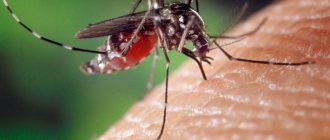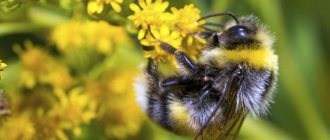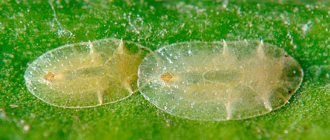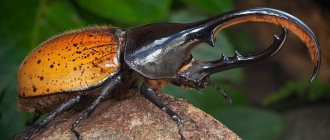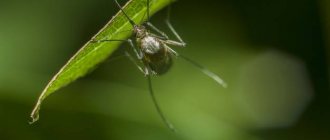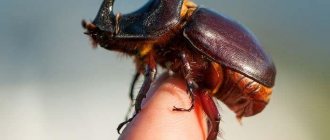Everyone in this world, be it a large animal or the smallest insect, has some characteristics that can protect them in case of danger.
A striking example to prove this fact is an insect such as the bombardier beetle. He is also called the crackling bombardier. The description of this species occurred in 1758 and belongs to Linnaeus.
Bombardier beetle (Brachinus sp.).
Appearances are deceptive
Bombardier is a beetle belonging to one of the subfamilies Brachininae (brachininae) or Paussinae (paussinae). Both of them belong to ground beetles.
Insects have a completely ordinary appearance; you will not find anything extraordinary when meeting them. The size of the beetle varies from a few millimeters to 1-3 cm. Its body and legs are bright red, sometimes dark brown. Most members of the ground beetle family lack the ability to fly, but they can move very quickly on their six legs. The hard elytra are most often painted in black and blue tones, but there are individuals with a beautiful greenish tint. Some insects have a pattern of rounded spots of contrasting color on their backs. The mustache consists of segments connected in a row up to 0.8 cm long.
Literature
- Carabidae Wikispecies
. Web. Last updated 8 December 2013. Author Unknown. - Streaked bombardier beetle buglife.org . Web. Accessed 16 December 2013. Author Unknown.
- ↑ 3,03,13,2 Bombardier beetle (Brachinus crepitans) ARKive.org . Web. Accessed 16 December 2013. Author Unknown.
- ↑ 4.04.1 Nagel, Peter. Flanged Bombardier Beetles from Laos (Carabidae, Paussinae) biogeography.unibas.ch
. Web. Published 2009. - ↑ 5.05.1 Donnelly, Andrew. Bombardier Beetle australianmuseum.net . Web. Updated: June 16, 2009
- ↑ 6,06,16,26,36,4 Poetker, Ezra. Brachinus fumans animaldiversity.ummz.umich.edu." Web. Accessed 17 December 2013.
- Rittenbach, Donovan. Explosive Bugs Hack Ant Colonies for Royal Treatment science.kqed.
org . Web. June 27, 2007. - ↑ 8,08,18,2 Evans, A. W. [ https://www.nwf.org/Wildlife/Wildlife-Library/Invertebrates/Bombadier-Beetles.aspx Bombadier Beetles ] Nfw.org
. Web. Accessed 1 January 2014. - ↑ 9.09.1 Hadley, Debbie. [https://insects.about.com/od/coolandunusualinsects/a/bombdefenses.htmBombardier Explosion Bugs] insects.about.com
. Web. Accessed 12 January 2014. - ↑ 10,010,110.2 Schwartz, Joe. Chemical protection from Bombardier Beetle chemicallyspeaking.com
. Web. Published on Sunday, August 15, 2010.
Reproduction, stages of development
At the end of the mating season, the female leaves to lay eggs. She will have the hard work of rolling the earth into small balls, which will serve as a container for the future larva. Place one egg in each soil lump.
Ground beetles are carnivorous beetles, and it costs them nothing to destroy other people's offspring. This is exactly what the larvae do. When they are born, they find the pupae of other insects and eat away their insides, starting from the head. Most often, mole crickets become victims. The empty chitinous shell will become a new home for the larvae. There, another metamorphosis awaits them, as a result of which a pupa is first formed, and then a young bombardier hatches. The beetle goes through its full life cycle in just 15 days.
Laying eggs
The female lays eggs immediately after mating . To do this, first of all, in the opinion of the beetle, a safe place is selected, where there is a lot of decaying plant foliage, dirt and stems. The larvae hatched from eggs lead a parasitic lifestyle; their main food is mole cricket pupae. They go through several stages of molting, after which they turn into adults. They live only 2 weeks, but in such a short period they manage to overcome all stages of development.
Fight the enemies!
Since ground beetles cannot fly, nature has endowed them with another protective function. If you cannot quickly escape from the enemy, the bombardier insect (beetle) enters the battle. It emits a hot stream of caustic substance. Small but annoying ants can die from a shot. Larger predators receive quite noticeable burns and will not risk attacking the enemy again.
Representatives of the subfamilies Brachininae and Paussinae have plenty of enemies. Amphibians - frogs, lizards - are eager to eat them. Birds are also not averse to trying a beetle snack. The persistent ants are trying to carry out an attack in several stages, because at home they are waiting for them with prey. Nature gave the bombardier a brightly colored head and paws for a reason. It is a signal for other inhabitants of the animal world. Seeing warning colors (red, orange, bright yellow), many will think before attacking, is the loot worth it?
What are the protection features?
The only feature of the insect is its specific defense mechanism. An interesting fact is that the sprayed liquid reaches 100 degrees. At the same time, steam rises around the beetle.
The insect has a special organ that produces a caustic substance
The beetle fires a chemical mixture when it senses potential danger. A burning liquid can be released by insects more than once in a short period of time. Features of the protective mechanism are presented in the table.
| Localization | The protective mechanism is located on the last segments of the abdomen, closer to the last legs. |
| What makes it stand out? | The chemical is secreted by symmetrical endocrine glands. |
| Compound | It consists of a toxic mixture of hydroquinone and hydrogen peroxide. Before release, the product is stored in a special compartment. |
Sensing potential danger, the insect reflexively contracts its muscles. This pushes the chemical into another compartment. There, under the influence of chemical reactions, heat is released and the mixture is instantly heated to high temperatures.
When the poison comes out, you can notice a relatively large amount of steam and hear a specific pop. Interestingly, the beetle can adjust the trajectory of the shot. The insect shoots exactly in the direction where the enemy is located.
Gas attack helps protect against predators
The chemical mixture protects against:
- ants;
- spiders;
- praying mantis;
- some subspecies of ground beetles.
The insect does not allow itself to be eaten. The enemy hit is instantly killed. Larger potential pests suffer massive burns. Therefore, they also cannot attack the bombardier:
- lizards;
- birds;
- frogs.
After damage to the top cover and the formation of burns, the enemy will not dare to attack again and will retreat.
Bombardiers are not so dangerous for people. It is impossible to die after contact with an insect. Upon close contact, the beetle also releases a chemical. If it comes into contact with the skin, a burn will immediately form. For this reason, it is better not to get too close to the ground beetle subspecies.
If it gets into the eyes, the chemical can cause decreased or loss of vision. After such an attack, a person should rinse their eyes with plenty of clean water and immediately call an ambulance.
If a dog tries to eat a bug, it may get burned
You must not contact the bombardier or the animal. Often cats and dogs try to eat the beetle. This will cause burns or damage to your eyes.
Aimed Shot
The ability to scald an enemy with a stream of poisonous boiling water is not the last surprise for the enemies of such an insect as the bombardier (beetle). Features of evolutionary development have turned the lower segments of the abdomen into high-precision weapons. In moments of danger, an individual is capable of turning its “gun” 270 degrees. This gives her the ability to conduct targeted fire in various directions.
More than one shot bursts out from the tail segment. Entomologists have conducted numerous studies using a variety of equipment. In slow motion, you can see that the beetle fires a whole cannonade of volleys. Moreover, the longer the insect rested from using its formidable weapon, the more productive its use will be. In a few minutes you can see up to 30 “shots”. Then the beetle will need time to “reload” the weapon. Even when caught by predators, the bombardier does not get lost. It shoots at the enemy's mouth, causing severe chemical burns. Few people will like this kind of prey.
Coleoptera brethren
Almost all carnivorous beetles have the ability to secrete liquids that are unpleasant to predators. Unlike other representatives of ground beetles, brachininae and paussinae heat up their “charge” and can conduct targeted fire.
The most studied are Brachininae, in particular, the cod bombardier. It is a unique representative of the Coleoptera family. Carl Linnaeus, a great biologist who devoted his life to work on the classification of flora and fauna, was the first to describe and study insects. The crackling bombardier is a beetle capable of firing up to 500 shots per second. The cannonade is accompanied by a loud sound and the release of toxic fog. It has a modest appearance for such outstanding abilities: reddish-red legs and head, body length less than 1 cm, dark elytra, colored in blue-green tones.
Although the beetle does not pose a serious threat to humans, it is better to refrain from closely examining the individuals. Once in the eye, a stream of hot poison can completely deprive vision. If you pick up an insect, you risk getting small but very painful burns.
Paussina
Paussinae are less studied, but are of great interest to entomologists. Among its fellows, the subfamily is distinguished by the structure of its mustache, which has a different shape. They may resemble a feather or be flat. The bombardier beetle (photo can be seen in the article) from the Paussinus tribe looks very impressive.
These individuals are otherwise called myrmecophiles. The special structure of their body allows them to fit into anthills and live inside someone else's house. Paussins can be narrow and long, or more squat and flat. Special glands of beetles produce a secretion that lulls the vigilance of ants, who mistake them for relatives. Such cohabitation can hardly be called a symbiosis, because only one side benefits. Harmful insects feed at someone else's expense and consume young ants.
Nutrition
Bombardier beetles are twilight and night hunters. Their medium-sized eyes are also adapted to this lifestyle. During the day they hide under snags, stones, in the grass or among fallen trees. The diet consists almost entirely of protein foods.
Bombardiers lay their larvae in the top layer of soil
This means that they feed on other living creatures - the larvae and pupae of other beetles, snails, worms and other small creatures that live in the top layer of soil, and carrion. They are not capable of flight, so they move only on their paws.
Thanks to their flattened shape, they easily make their way among fallen leaves, running around their hunting grounds. They orient themselves with the help of antennae, which can replace almost all their senses - hearing, vision, smell and touch.
They grab their prey with tenacious front and middle paws with jagged edges. The victim cannot escape from the deadly embrace, and after some resistance he calms down and resigns himself to his fate. However, these predators also have many enemies, some of them have learned to perfectly defend themselves against the “shots” of insects.
For example, birds shield themselves from the “shot” with their wings, some rodents jump on top of the insect and press its deadly weapon into the ground, and the seemingly harmless horsefly larva buries the beetle itself in damp soil, which absorbs the poisonous liquid.
However, the bombardier beetle defends itself even after defeat. They watched as a beetle swallowed by a frog shot while inside, and the poor amphibian, out of fear and internal burn, spat out the fighter.
Shot physics
Entomologists conducted a lot of experiments before understanding the weapon structure of the bombardier insect (beetle). A description of the processes occurring inside could only be obtained using special equipment. Through dissection, scientists found that the abdominal cavity of the individual has two small glands. Each of them produces and accumulates substances that differ in their chemical composition - hydrogen peroxide and hydroquinone.
And the process of interaction of reagents and their release was carefully studied by the staff of the Massachusetts Institute of Technology. Cristina Ortiz's team used synchrotron X-ray imaging to uncover the secrets of bombardiers' natural defenses.
The work showed that a series of physical and chemical changes occur inside the abdomen. The reaction chamber (in which the components are mixed) is equipped with a thick layer of chitin and has several elastic membrane valves. One of them allows chemical components to enter the tank, after which it blocks the return flow of the reagents. The upper area of the chamber swells and presses on the lower one. When the pressure increases to its maximum, the membrane of the last abdominal segment opens and releases a hot stream outward.
How can this be?
Dr Andy McIntosh. As an engineer, Dr. Andy McIntosh studies the bombardier beetle from a unique perspective. A seemingly small incident in 2001 changed Andy's life. He was sitting in his office at the University of Leeds in England, where he had been conducting research for 15 years (and would continue for another ten years). While reading a copy of the Proceedings of the Natural Academy of Sciences, he noticed an article about the bombardier beetle, an insect that squirts boiling water and chemicals from its rear end.
Looking at photos of a beetle shooting chemicals out of its tail is something most of us can only spend a few minutes with, but not Andy. A person with a PhD in combustion theory doesn't see the world the way we do. He knew there had to be more to this story.
Biologists have known about the beetle since the early 1800s, when the first reports of beetles firing like "artillery" were published. Later, in the 1960s and 1970s, the world's leading bombardier beetle expert, entomologist Thomas Eisner, made some exciting discoveries about the beetle's complex chemistry, but many mysteries remained.
What caught Andy's attention in the new report was the apparent evidence of combustion, his area of expertise: something amazing happens for an insect to cause a series of explosions and then machine-gun its enemies.
Andy wasn't interested in the bombardier beetle the way a biologist might be. He was interested in technology and physics. As those who believe in creation, we know that God created this complex chemical system (which includes specialized chemicals that speed up reactions) as well as the combustion chamber, the movable tip of the abdomen, like an exhaust tower (more versatile than tank turret), intake and exhaust valves and a sensing mechanism to determine in which direction an attack may begin. Andy wondered if it was possible that the Designer God had implemented some unique engineering solutions for miniature explosions that human industry could adopt and imitate (biomimicry) for our benefit.
We may not know the purpose of the blast jet in a perfect world before Adam's fall, but Andy wanted to know more about the engineering. He visited his university's biology department to see if anyone else might be interested in the mechanics of the beetle's unique weapon system.
To his surprise, one of the biologists not only showed no interest, but also asked why Andy needed this: “What do you hope to find out, since the beetle is still evolving?”
The lack of curiosity shocked Andy. “I'm interested in how things work. Since I knew that the Chief Designer was designing animals, I expected to discover new ideas in the field of combustion and engineering. Instead of being a hindrance, my faith in God's creation opened up a new area of exploration. It was because I believed in the creation of the world that I was motivated to ask the right questions.”
He turned to the author of the Bombardier Beetle article, Dr. Eisner, who worked at Cornell University. Andy had no idea what doors this decision would open for major research that continues to this day, including new discoveries and patents.
Chemistry of the process
To understand what bombardier beetles shoot at their opponents, you will have to delve into chemistry. One of the reservoirs releases hydroquinone, and the second hydrogen peroxide. The reaction chamber contains small glands that produce catalase and peroxidase. Before firing, the beetle squeezes them, spilling the contents into the reactor. Two chemical processes take place in this reservoir - enzymes decompose peroxide to atomic oxygen. It converts hydroquinones to quinones. Both reactions take place with the release of a large amount of thermal energy, which heats the mixture to 100 degrees. The pressure inside the chamber increases and, having passed the equilibrium point, opens the outer valve.
The insect independently regulates its aiming and the process of releasing a poisonous jet. Its speed can reach 8 m/s, and the range of the cloud varies from 1 to 10 cm.
Links[edit]
- ^ abc Aneshansli, DJ; Eisner, T.; Widon, J.M.; Weedon, B. (1969). "Biochemistry at 100 °C: explosive secretory discharge of bombardier beetles (Brachinus)". The science
.
165
(3888): 61–63. DOI: 10.1126/science.165.3888.61. PMID 17840686. S2CID 96158109. - ^ab Stanley A. Rice (2007). Encyclopedia of Evolution. Publishing an information base. p. 214. ISBN 978-0-8160-5515-9.
- ^ ab Isaac, Mark (30 May 2003) [1997]. "Bombardier Beetles and the Design Argument". TalkOrigins
. Retrieved August 3, 2022. - “See how amazingly a beetle survives being eaten.” National Geographic News
. 2018-02-06. Retrieved September 17, 2022. - Bombardier Beetle. Animal facts and photos
. Dallas Zoological Society. 2004. Archived from the original on 2011-07-08. Retrieved July 17, 2010. - Poetker, E. (2003). "Brachinus fumans". Animal Diversity Network
. - Eisner & Aneshansley 1999
- Dean, J.; Aneshansli, DJ; Edgerton, H. E.; Eisner, T. (1990). "Protective spray against bombardier beetle: Biological pulse jet." The science
.
248
(4960): 1219–21. Bibcode: 1990Sci...248.1219D. DOI: 10.1126/science.2349480. PMID 2349480. - Piper, Ross (2007). Unusual Animals: An Encyclopedia of Curious and Unusual Animals. Greenwood Press. ISBN 978-0-313-33922-6.
- ^ ab Weber CG (Winter 1981). "The Bomber Beetle Myth Debunked". Creation/Evolution
.
National Center for Science Education. 2
(1): 1–5. - ^ ab Isaac, Mark (30 May 2003). "Bombardier Beetles and the Design Argument". TalkOrigins Archive
. - Brunet, P.C.J.; Kent, P. W. (1955). "Mechanism of sclerotin formation: involvement of beta-glucoside". Nature
.
175
(4462): 819–820. Bibcode: 1955Natur.175..819B. DOI: 10.1038/175819a0. PMID 14370229. S2CID 4206540. - Eisner, T.; Aneshansli, DJ; Eisner, M.; Attygalle, AB; Alsop, D. W.; Meinwald, J. (2000). "The spray mechanism of the most primitive bombardier beetle (Metrius contractus)". Journal of Experimental Biology
.
203
(8):1265–75. PMID 10729276. - Irreducible complexity reduced to size on YouTube - GrrlScientist (17 January 2011). "Irreducible complexity reduced to size". The keeper
. This video is specifically dedicated to debunking the so-called "irreducible complexity" favorite examples used by creationists; eye, bombardier beetle, venereal flytrap and bacterial flagella.
Why doesn't the bomber explode?
Why, in the presence of such a dangerous laboratory, does the bombardier beetle itself not explode inside? Interesting facts were discovered by scientists based on multiple studies. The same elastic valves that regulate the processes of reagent supply and release are a protective element. Contraction of the membranes reduces the pressure and prevents an explosion inside the tiny “chemist’s” body. The beetle independently regulates the ejection process and the number of volleys. Evolution has taught Coleoptera to control the thickness of their body coverings.
Quick reloading of the “gun” allows you to fire several shots at intervals of a split second. In such an insignificant time, the reaction chamber manages to cool down and protect the individual from possible overheating. The beetle has a gland that produces an inhibitor that can quickly extinguish the chemical reaction.
Helper Beetle
Scientists from the UK claim that revealing the secrets of the mechanism of the beetle’s “gun” can be used in aviation. It is possible that the peculiarities of the jet emission will form the basis for a restart system for jet engines. Aeronautical engineers want to create a device that can accurately inject plasma into an internal combustion chamber.
Since the bombardier beetle’s “gun” has high accuracy, weapons are being developed that can replicate the insect’s success. The protective functions of brachinin are compared to the principle of the German V-1 bombs.
Participant in theological discussions
Bombardier is a beetle that has become a real stumbling block among creationists. These people developed a special theory, according to which all life on Earth occurred as a result of the actions of the “Higher Intelligence”. Some adherents argue that such a complex defense system could not have been the result of long evolution. If the different parts of the "laboratory" had evolved gradually, then this species of beetle would not have been able to survive. According to the theory, the “Higher Intelligence” created a project and overnight endowed insects with a protective mechanism of divine origin.
Entomologists have refuted the religious attacks of creationists. The large number of varieties of the brachinine and paussin subfamilies contributed to the knowledge of various mechanisms of formation of substances in reaction chambers and methods of firing. This allowed us to draw conclusions about the approximate process of evolutionary changes in the beetle's defense system. Scientists claim that nature made contributions with an emphasis on strengthening the walls of the reaction chamber and increasing the elasticity of the valves.
Ecology
Range map showing the location of bombardier beetles of the genus Brachinus
Various species of bombardier beetles can be located on all continents except Antarctica (the range map shows only bombardier beetles of the genus Brachinus and therefore lacks the location of species from the subfamily paussinae). The species Brachinus fumans lives only in North America while Brachinus crepitans lives in various parts of Europe including central Sweden, southern England, and south Wales, as well as parts of northern Africa. [6] Brachinus crepitans mainly lives in coastal areas, but they have been seen in inland areas. [3] Most bombardier beetles prefer to live in temperate [[forests]] or [[grasslands]], but Brachinus fumans lives in deserts, savannas, chaparral and forests. [6] Although many species prefer these conditions, bombardier beetles vary considerably in habitat settings.
Like other members of the family Carabidae, bombardier beetles are [[carnivores]] and feed on [[insects]]. In its adult stage, the bombardier beetle typically hunts either on the ground or in trees. Even in the larval stage, beetles consume other insects to provide energy for growth. [5] Bombardier beetles are rarely hunted due to their defense mechanism (see defense mechanism). This defense mechanism often repels [[predators]] who try to move too close to the beetle. [9]

